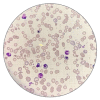Late-Life Presentation of Unsuspected G6PD Deficiency
- PMID: 30356359
- PMCID: PMC6176296
- DOI: 10.1155/2018/8198565
Late-Life Presentation of Unsuspected G6PD Deficiency
Abstract
Deficiency of glucose-6-phosphate dehydrogenase (G6PD) is the commonest enzyme deficiency in humans with a wide range of possible clinical manifestations depending on the specific genetic variant in each case. Here we present the case of an 86-year-old male of African descent who acutely developed symptoms of G6PD deficiency immediately after he received methylene blue for treating methemoglobinemia. The contrast between a low SO2 on pulse oximetry and a normal arterial gas sampling raised the possibility of methemoglobinemia. The patient was treated with packed red blood cells and folic acid, and a rapid clinical improvement followed by normalization of the red blood cell count ensued. In view of the patient's advanced age, the lack of a history of similar episodes in the past, and the normal laboratory results during the hemolytic crisis, this case remained a diagnostic challenge for over three months, when a follow-up measure of G6DP activity eventually confirmed the diagnosis. A latent deficiency of G6PD may become clinically manifest under the appropriate triggering conditions even in elderly patients and in the absence of past or current clinical and laboratory evidence of G6PD deficiency.
Figures
Similar articles
-
Rasburicase-Induced Methemoglobinemia in a Patient with Glucose-6- Phosphate Dehydrogenase Deficiency.Curr Drug Saf. 2017;12(1):13-18. doi: 10.2174/1574886312666170111151246. Curr Drug Saf. 2017. PMID: 28078984 Review.
-
Study of Glucose-6-Phosphate Dehydrogenase Deficiency: 5 Years Retrospective Egyptian Study.Endocr Metab Immune Disord Drug Targets. 2018 Feb 13;18(2):155-162. doi: 10.2174/1871530317666171003160350. Endocr Metab Immune Disord Drug Targets. 2018. PMID: 28982343
-
Co-Occurring Hemolysis and Methemoglobinemia After COVID-19 Infection in Patient With G6PD Deficiency.Cureus. 2023 Feb 15;15(2):e35020. doi: 10.7759/cureus.35020. eCollection 2023 Feb. Cureus. 2023. PMID: 36938163 Free PMC article.
-
Mortality following rasburicase-induced methemoglobinemia.Ann Pharmacother. 2013 Oct;47(10):1353-8. doi: 10.1177/1060028013501996. Epub 2013 Oct 21. Ann Pharmacother. 2013. PMID: 24259700
-
Review and drug therapy implications of glucose-6-phosphate dehydrogenase deficiency.Am J Health Syst Pharm. 2018 Feb 1;75(3):97-104. doi: 10.2146/ajhp160961. Epub 2018 Jan 5. Am J Health Syst Pharm. 2018. PMID: 29305344 Review.
Cited by
-
Favism: A Case Report.Cureus. 2022 Mar 17;14(3):e23269. doi: 10.7759/cureus.23269. eCollection 2022 Mar. Cureus. 2022. PMID: 35449616 Free PMC article.
References
-
- Beutler E. The molecular biology of enzymes of erythrocyte metabolism. In: Stamatoyannopoulos G., Nienhuis A. W., Leder P., Majerus P. W., editors. The Molecular Basis of Blood Disease. Vol. 29. Philadelphia, USA: WB Saunders; 1993. - DOI
Publication types
LinkOut - more resources
Full Text Sources
Miscellaneous


